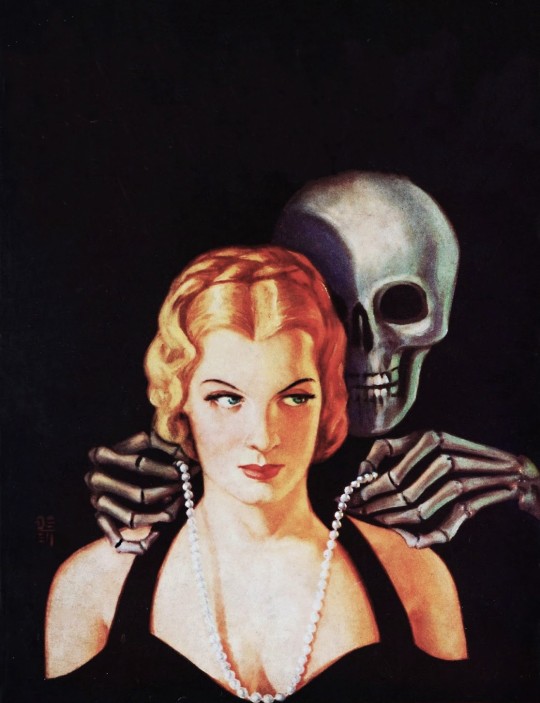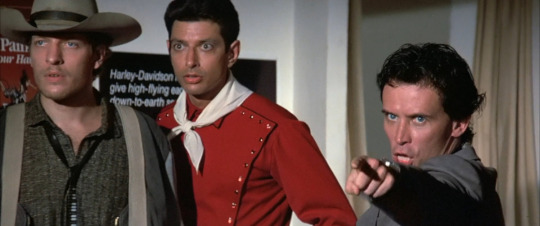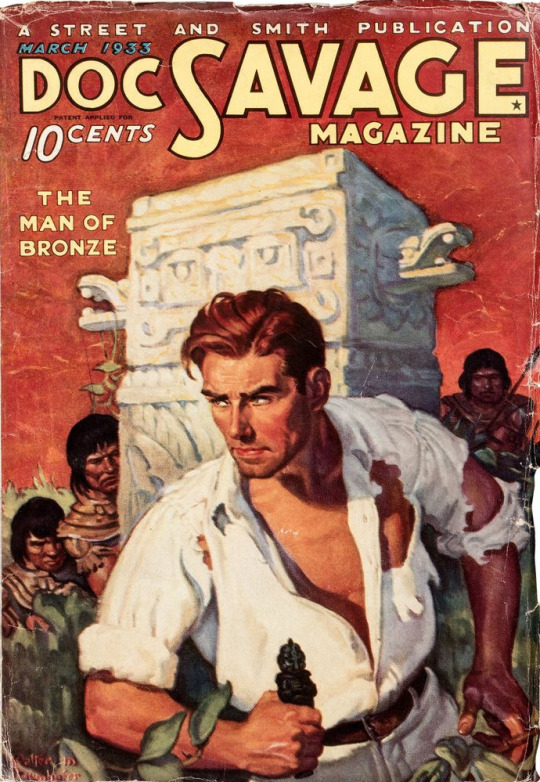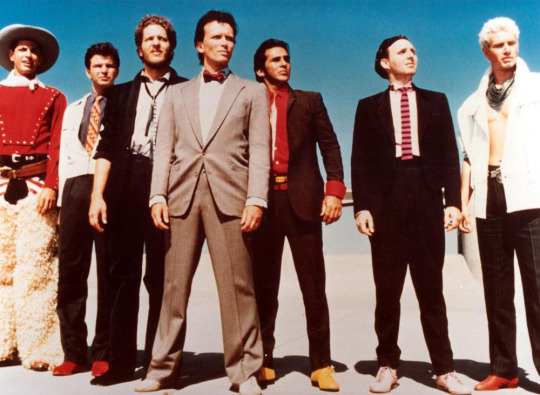#pulp art 1933
Explore tagged Tumblr posts
Text

Salesman for Death - art by Rafael DeSoto (1933)
#rafael desoto#pulp art#all detective magazine#30s horror art#mystery novel#cover art#frederick c. painton#pulp artist#1930s#1933
251 notes
·
View notes
Text

Vintage Pulp - Honeymoon Tales (June1933)
Novel Idea
#Pulp#Magazines#Honeymoon Tales#Marriage#Novel Idea#Boxing#Sports#Vintage#Art#Illustration#Pulp Art#Pulp Illustration#1933#1930s#30s#Romance
36 notes
·
View notes
Text

Weird Tales - October 1933 (Popular Fiction)
This classic bat-woman cover by Margaret Brundage makes this one of the most sought-after issues of Weird Tales, as well as a highly desired pulp in general.
the most tumblr-centric art ever
also that NRA symbol is for the National Recovery Administration, a Roosevelt program from 1933 that was VERY popular with workers.
79 notes
·
View notes
Text

August 1984. This won't change anyone's feelings about cult movie perennial THE ADVENTURES OF BUCKAROO BANZAI: ACROSS THE EIGHTH DIMENSION one way or the other, but if you're wondering what the hell the deal is supposed to be with Buckaroo Banzai and his team, the answer is, "It's an obvious pastiche of the pulp hero Doc Savage."
Launched in 1933, Doc Savage was one of the leading adventure heroes of the pulp magazines. Doc (whose full name was Clark Savage Jr.) was scientifically trained from childhood to the peak of human perfection, singularly adept in everything from mechanical engineering to medicine to martial arts. He had a secret headquarters called the Fortress of Solitude and a whole array of specially designed vehicles and equipment, but he was also a public figure, with offices in the Empire State Building. Doc had a team of eccentric, highly specialized aides — Monk Mayfair, Ham Brooks, Renny Renwick, Long Tom Roberts, and Johnny Littlejohn — who each had a particular skill and a couple of distinctive personality traits (for instance, Monk was a skilled industrial chemist, but also an "ape-like" brute with a ferocious temper). They were sometimes aided by Doc's cousin, Pat Savage, who was almost as capable as Doc, although he tried to keep her out of the fray because she was (gasp) a girl.

This was a fairly common pattern for pulp heroes. For instance, the pulp version of the Shadow (who was distinctly different from the radio incarnation) relied on a whole network of agents, some appearing only once or twice, some recurring across many of his published adventures. From a narrative standpoint, the agents and assistants had two principal purposes: The first was to offset the rather overpowered heroes — pulp heroes didn't necessarily have superhuman powers, but even those who didn't tended to be preternaturally skilled at nearly everything, so it was convenient to limit their direct involvement in an adventure to crucial moments, and let the assistants (who could be much more fallible) do much of the legwork. The second object was to beef up the characterization. Doc Savage was morally irreproachable as well as absurdly multi-talented, so there wasn't a lot to be done with him character-wise, while maintaining the mystique of a character like the Shadow required him to remain a fairly closed book.
Although the pulp heroes were a huge influence on early comic book superheroes like Superman and Batman, some of these conventions didn't translate well to other media: In a 13-page comic book story or half-hour radio episode, having too many characters was cumbersome (and expensive, where it meant hiring extra actors), and comic book readers normally expected to follow their four-color heroes quite closely, even before the breathless internal monologue became a genre staple. So, Superman inherited Doc Savage's Fortress of Solitude, but not his "Fabulous Five" assistants, while heroes like Batman and Captain America generally stuck with a single sidekick rather than a team of aides. Even the late Doc Savage pulp adventures (which ended in 1949) de-emphasized the assistants to keep the focus more on Doc himself. Ultimately, the pulp heroes didn't really have the right narrative center of gravity for visual media, which is why they've become relatively obscure, despite repeated revival attempts. The 1975 Doc Savage movie with Ron Ely, for instance, was a notorious commercial flop, and elements like Doc's childishly bickering assistants seemed odd and dated, even taking into account the film's nostalgia-bait '30s period setting.
What BUCKAROO BANZAI tried to do was to bring that old pulp hero formula into the modern era with a big infusion of '80s style and humor. Like Doc Savage, Buckaroo is a wildly gifted polymath (in the opening scenes, he rushes from performing brain surgery to test-driving his Jet Car through a mountain), so famous and important a personage that he puts the president of the United States on hold, and he surrounds himself with an array of brilliant, eccentric aides with silly nicknames who play in his rock band when they're not fighting crime or doing advanced scientific experiments.

Alas, judging by the poor box office returns, general audiences were no more amenable to the '80s version of this formula than they had been to DOC SAVAGE: MAN OF BRONZE nine years earlier, even with the 1984 film's extraordinary cast and memorably witty dialogue. Granted, even many of the movie's most diehard fans are baffled by the convoluted plot — a crucial expository scene where the leader of the Black Lectroids (Rosalind Cash) explains much of what's going on is nigh-incomprehensible without subtitles or closed captioning — but beyond that, THE ADVENTURES OF BUCKAROO BANZAI is essentially an extended riff on a particular slice of pop culture that had long since dropped out of the public consciousness, which is both part of its charm and also its commercial undoing, at least as mainstream entertainment.
(Also, if you're wondering, yes, the TOM STRONG series by Alan Moore and Chris Sprouse is also an obvious Doc Savage pastiche, although at least some of its plot and character concepts were probably retoolings of unused ideas from Moore's earlier Maximum Press/Awesome Comics SUPREME series, which was an extended pastiche of the pre-Crisis Superman.)
#movies#buckaroo banzai#the adventures of buckaroo banzai across the eighth dimension#w.d. richter#peter weller#jeff goldblum#clancy brown#doc savage#pulp heroes#street and smith#walter m baumhofer#the shadow#michael santoro#pepe serna#billy vera#lewis smith#one of the amusing things about the jeff goldblum character#is that his eccentricity clearly precedes his involvement with buckaroo banzai#he's just a brilliant neurosurgeon who's been looking for a chance#to wear his roy rogers outfit and fight crime
138 notes
·
View notes
Text

“Published in 1933, this rare, historical issue was the very first comic book to appear on newsstands that contained all new, original artwork centered on a single theme. All comic publications prior to DETECTIVE DAN contained comic strips, were books, or were compilation reprints of comics previously published in newspapers. In most respects, DETECTIVE DAN, SECRET OPERATIVE 48 is the cornerstone of the comic book media and art-form we know and love today. Detective Dan was created, written and drawn by Norman Marsh, and the 10x13" comic book was a one-shot single issue. However, the ground-breaking character went on to enjoy exposure in newspaper strips, Big Little Books and pulp magazines (as well as merchandising). In many respects, Detective Dan was a clone of the character, Dick Tracy, with his fedora, square jaw, and penchant for fisticuffs. In addition to DETECTIVE DAN, SECRET OPERATIVE 48's groundbreaking role in comic book history, both the comic's title and the Wu Fang character that the story contained are said to have inspired Detective Comics #1 published 4 years later. As comic aficionados know, that series lead to the name of the publisher, DC Comics, and gave birth to the hero Batman in 1939.”
8 notes
·
View notes
Text

On this day in 1897, Bram Stoker’s Gothic horror novel “Dracula” was published by the Archibald Constable and Company.
‘The Bat-Man’ first appeared in Bill Finger & Bob Kane’s “The Case of the Chemical Syndicate” in Detective Comics #27 on March 30, 1939. It is no surprise that Kane and Finger were inspired by not just heroes of the screen like Zorro but by the pulp fiction magazines at the time, such as Walter B. Gibson's ‘The Shadow’ created in 1931, 1933's ‘The Phantom Detective’, and comic strip's ‘Dick Tracy’. Even costumed heroes such as 1936's ‘The Phantom’ and 1938's ‘Superman’ all played a part into making the Batman.
Beyond the pulp magazines that hit the newsstands, there were literary novels that inspired the Gothic look of the shadow of the bat. Irish author Bram Stoker's 1897 novel "Dracula" possessed the dark romanticism and the bleak visuals much Gothic literature of the Victorian era encompassed. More so, Dracula, a vampire from Transylvania moving to England to find fresh blood, was a creature of the night that literally struck fear into the hearts of his victims. This 19th century literature made the nocturnal figure one to use as a model for the Dark Knight and proved to be the foundation of the visual prowess that became an overnight sensation in 1939. #WorldDraculaDay 🦇🧛🏼♂️📚
🖼���: Art by Bob Kane & Sheldon Moldoff, 1939’s Detective Comics #32; Stills of Bela Lugosi in Tod Browning's 1931 film “Dracula”.
1 note
·
View note
Text
Comics I Read Today
April 14

Doc Savage: The Man of Bronze. The Devil’s Thoughts #1 (1991)
Doc Savage was an adventure character published in pulp magazines beginning in 1933. Today, he would be considered a super-hero due to his super intelligence and peak physical conditioning.
Every time I would see a Doc Savage comic, I would snatch it up. I enjoyed most of the stories, especially the ones set in the 1930s. But I hated this one by Millennium Publications at all. It’s plagued by bad art, poor storytelling and muddy coloring. It’s probably a good thing Millennium didn’t hold the license for long.
1 note
·
View note
Text
Zoe Mozert was born Alice Adelaide Moser on April 27, 1907 in Colorado Springs, Colorado. Her father was Fred William Moser, a mechanical engineer of German ancestry. The family name had orignally been Motzar, but that was changed to Moser when her grandfather emigrated to America. Her mother was Jessie Mable Hatfield of Ohio. Her parents married in 1906 and she was their first child.
From 1925 to 1928 she studied at the Philadelphia Museum School of Industrial Art, where she took advanced classes with Thorton Oakley in 1927 and 1928. The future pulp artist, H. J. Ward, was also a student in that same class. She paid for her tuition by modeling at the school. She most likely also posed for H. J. Ward, several of whose paintings from this time period portray a woman with strikingly similar features. She began her career as an artist in 1927, while working for the Pittsburgh Plate Glass Company. She soon began her own window display business.
In 1932 she moved to New York City to look for entry-level freelance work in the magazine industry. Her first illustration jobs were for Bernarr Macfadden's True Story. At this time she adopted a professional name, "Zoe Mozert." According to the artist, "I looked through a name dictionary for a new first name and when there were finally no pages left I settled on Zoe."
In 1933 she won a scholarship in a talent contest to study at the Art Students League.
From 1934 to 1937 she created many sensual and glamourous covers for pulp magazines, such as Smart Love Stories, Love Revels, and Night Life Tales. Fawcett Publications hired her to work full time as a staff artist on True Confessions, but at the same time she also worked in her free time as a freelance artist. In this way her work appeared in a wide range of glamour magazines, such as American Weekly, Romantic Movie Stories, Romantic Stories, and Screen Stories.
She was soon a prosperous and busy illustrator, who had grown beyond the low-paying pulp magazine industry. On Janury 9th 1937 she rented a nicer apartment at 29 West 12th Street in the fashionably artistic Greenwich Village section of Manhattan. By 1937 her unique style of illustration was so central to the ideal of Hollywood glamour that she was hired by Paramount Pictures to create the movie poster for the film, True Confession, starring Carole Lombard.
She also illustrated advertisements for such products as Dr. Pepper, Kool Cigarettes, Irresistible Beauty Aids, Mentolatum, and Raleigh Cigarettes. Many of these advertisements featured her distinctive pastel portraits of famous movie stars as product endorsements.
She also worked as an art adviser and painter with Warner Brothers in Hollywood. She created many artworks that were used as props within films, such as Never Say Goodbye starring Errol Flynn, and Calendar Girl starring Patricia O'Neil. She also painted the controversial movie poster of Jane Russell for the classic Howard Hughes film, The Outlaw.
In 1978 she retired to Sedona, Arizona, where she lived outside of town on Schnebly Hill Road, She continued to create pastel drawings and portaits, which were sold in fine art galleries.

Zoe Mozert - "Beauty by Night" - 1946 Calendar Illustration - Brown & Bigelow Calendar Co.
168 notes
·
View notes
Text

The Shadow Magazine Aug 1 1933
George Rozen
#golden age art#pulp magazine art#pulp art#pulp art 1933#The Shadow Magazine#George Rozen art#byronrimbaud
20 notes
·
View notes
Photo

art by Margaret Brundage (1933)
401 notes
·
View notes
Text





5 Random Pulps - Film Fun
Art by Enoch Bolles
#5 Random#5 Random Pulps#Pulp#Film Fun#Enoch Bolles#Vintage#Art#CGC#Illustration#GGA#Good Girl Art#Cheesecake#Women#1933#1934#1935#1930s#30s#Pulp Art#Pulp Illustration
18 notes
·
View notes
Photo

Weird Tales, November 1933 Cover by Margaret Brundage
306 notes
·
View notes
Text

Honeymoon Stories - September 1933 (Novel Idea)
Bookery's lists this obscure pulp as "rare", and this is the first copy we've encountered.
22 notes
·
View notes
Text



Amazing Stories (1933)
#Amazing Stories#Pulp#Sci-Fi#Science Fiction#Magazines#Vintage#Art#Illustration#Design#1933#1930s#30s
55 notes
·
View notes
Photo

Vintage Pulp - Real Detective (Sept1933)
23 notes
·
View notes
